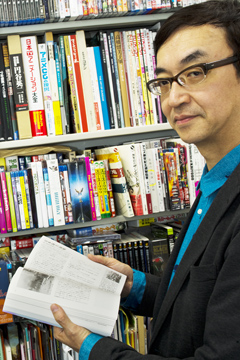Even if you’re not the super enthusiastic type of anime lover who reads anime magazines and mooks, if you’re a person with love for Evangelion, you’ve likely come upon an article of his at some point. The guest of route2015’s third interview is Ryusuke Hikawa, who built himself a reputation as an anime and tokusatsu researcher. On the Eva front, his name might ring familiar from the immense staff interview articles published in the pamphlets sold in movie theaters for each episode of the new movies and in the official document collection of the movie, titled Zenkiroku Zenshuu (Complete Records Collection). The subject he pursues remains the same since the second half of the ‘70s, the early period of anime magazines: “Why does animation shake the hearts of people?” He is trying to find part of the answer to that simple yet profound question by continuing his involvement with Evangelion.
Taken in cooperation with Nakano Campus, Meiji University

Meiji University Graduate School Guest Professor
Anime and tokusatsu researcher
Ryusuke Hikawa
Born in 1958 in Hyogo Prefecture. During college in 1977, he became a writer and editor for the Space Battleship Yamato special in the second issue of the subculture magazine OUT and has been involved in numerous anime and tokusatsu-related mooks and records since. In ‘97, he published his first book, titled 20-nenme no Zambot 3 (The 20th Year of Zambot 3). Currently, besides his writing activities as an anime and tokusatsu researcher and related appearances in various media, he also works as a guest professor at the Graduate School of Global Japanese Studies of Meiji University.
As an Anime Fan, I Felt Something Was Wrong with the Big Boom of the ‘90s.
Seizing the opportunities created by the anime boom occurring in the second half of the 1970s, a whole variety of small and large publishers launched anime magazines. Hikawa used to be the head of the Space Battleship Yamato fanclub at university at the time he started working during college, and he has been writing articles since that time when the title “anime writer” didn’t even exist.
“Regarding my job at the time, I was a jack-of-all-trades. I didn’t just write articles, I also configured the layout of the magazine as an editor, and sometimes I even went as far as doing jobs of that of a cameraman or designer.”
It would be accurate to say that the basic ingredients of the anime magazines and mooks continuing until now has been laid down mostly by Hikawa’s generation.
At some point, Hikawa also started working at King Records and participated in the album composition of Future Boy Conan and even in the soundtrack of Mobile Suit Gundam. The wide range of experiences he made are the basis for widening his knowledge to support his present research activities. After graduation, he found work at a maker, and for almost 18 years until his resignation in 2001, he worked as a telecommunications engineer as his main job.
The genuine revival of his writing activities came in 1997, when he authored 20-nenme no Zambot 3 (The 20th Year of Zambot 3). This was just around the time the first Eva movie was released, heating up debates revolving around the series.
“The Neon Genesis Evangelion’ hit was special in the aspect that rather than just another anime boom, it brought upon an expansion of the subculture as a whole with the inclusion of such a boom. The first movie was released almost 20 years after the Gundam boom. In a sense, Japanese anime was trying to enter its next maturation period.”
At the time, most anime magazines and mooks were taken by the subject of Eva.
Enthusiastic fans infatuated by the story were absorbed in “mystery solving” of the story and settings, and countless related publications called mystery and investigative books lay in piles in bookstores. It was a phenomenon caused by the style of Eva that incorporated many essences ranging from science fiction to mystery, psychology, and even religion.
“Among them, there were even nearly academic books parsing Evangelion spreading to the fields of sociology and philosophy. However, the circumstances as a whole gave me the feeling that there was a steady tendency of moving away from essential “animation.” What in Evangelion could shake the souls of its viewers so much? From whose thoughts and with what methodology was it made, and how did it land so accurately? People were surprisingly indifferent toward such questions, and it seemed to me that the more incandescent the theories became, the more hollow they became at their core; it was bothering me.”
In the ‘90s, we advanced from video tape to laser discs, then to DVDs, making it easy for an individual to keep videos. From the point of the anime fans of the Gundam generation who were constantly hungry for videos, this was a most welcome progress.
“Although at present, the way of calling it ‘content’ is quite widespread, I think it’s effect on the heart, that is, assuming ‘content=what’s inside’, is neglected. In a time when you couldn’t record video, there was a kind of resonance between the anime and the audience, like what you felt when you were sitting in front of the TV in suspense every week. It feels that this, on the contrary, has become weaker. More than 50 years have passed since anime reached its prosperity with Astro Boy, but it hasn’t even been systematized the way music and movies are. If our generation doesn’t work on it, there is a possibility that anime might not remain as an accepted culture. First of all, we, the receivers, should watch them thoroughly, leave notes, arrange and historicize information, and verbalize impressions. I was aware of such danger, so I took the lead and tried writing a book.”
Taking the revival of his writing activities in ‘97 as an opportunity, Hikawa became independent as a writer in 2001 and started his activities in the field of researching anime and tokusatsu.
“There is no doubt that it was Evangelion that gave me such a great chance. It was the realization that the anime was depicting a similar “sense of danger.” I’m sorry for not quoting accurately, but Anno (the supervising director) himself said that the world where the population has decreased by half was a metaphor to the anime industry, which seemed to be having a recession at the time. I was also shocked by what Rei Ayanami’s clone said, that ‘a soul can only reside in one body.’ That might also be a reflection of the circumstances Eva was placed in at the time.”

